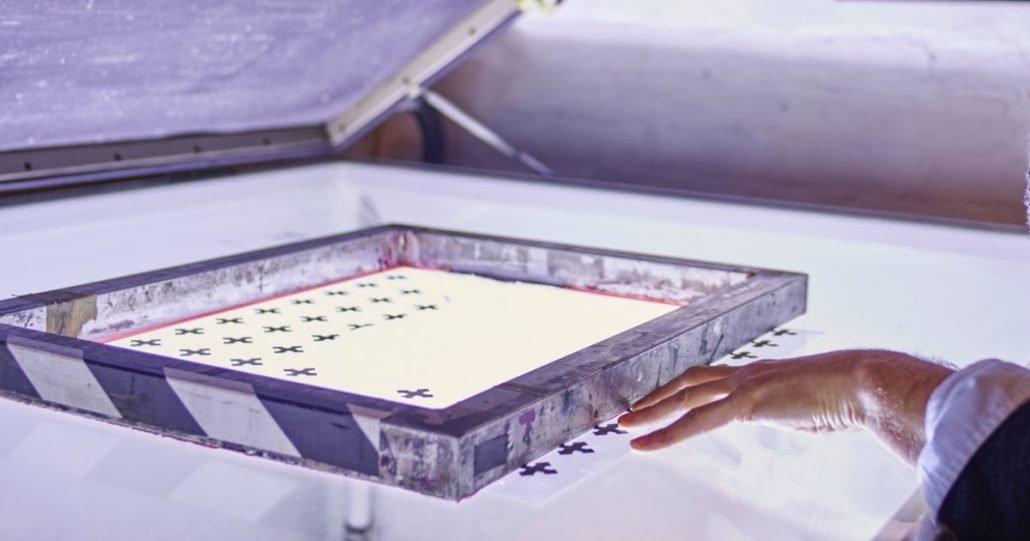Silk screen printing on metal surfaces is a versatile and widely used technique that allows for vibrant designs and long-lasting finishes. Whether you’re looking to add branding to metal products or create custom artwork on metal, silk screen printing offers a range of possibilities. This blog post will explore the typical applications, metal substrates, and the silk screening process. We’ll also discuss the advantages and considerations of silk screening on metal and alternative printing methods, offering a comprehensive perspective on when to choose silk screen printing for your metal products.
Common Applications of Silkscreen Printing on Metal
Silk screening on metal finds widespread use in a variety of applications. It is commonly employed for branding and labeling metal products, conveying visual safety messages, and creating designs and decorative patterns on metal art.
- Logos – Get brands seen
Screen printing is a popular technique for visual branding creation. Brands can convey the value and personality of a brand through its logos, colors, and other design elements.
- First Aid and Safety Signage – Convey visual message
Screen printing provides a reliable solution to conveying important guiding messages and warnings. For example, on the hazardous material signs, the message can be screen printed on the metal sign to indicate what dangerous goods are loaded for transportation or storage. Another example is the metal first aid boxes and cabinets, where we need a remarkable first aid sign for easy and clear identification during emergencies. Screen-printed first aid markings ensure long-lasting use and non-faded colors.

- Decoration – Enhance products with artistic elements
On some metal crafts, vibrant colored designs are used to enhance the visual appeal of the products.
- Promotional gift items – Promote unique and branded campaigns
Screen-printed artwork elements blend naturally with the products, which elevate the branding for an extended period.
- Instrumentation – Create long-lasting markings
On the control panels, dials, and gauges, numbers and scale lines can be screen printed to resist fading and ensure a long period of use.
- Electronics devices – Communicate essential safety information
On the metal casings or panels of electronic devices, screen-printed information helps to communicate information such as model numbers, safety warnings, or usage instructions. The durable printing ensures the information remains clear and intact after extended use.
Metal Substrates for Silk Screening
We can use silk screening on various metal substrates, including stainless steel, powder-coated steel, aluminum, brass, and more.
Screen printing on powder-coated metal
In certain metal products, the metal fabrication ends with a surface finishing step, enhancing the surface’s smoothness and durability. The finishes make it easier for the screen print ink to bond with the metal surface, ensuring a long-lasting effect.
For example, we use silk screening to apply graphics on powder-coated metal. Powder-coated metals have a protective layer of coating that we add by using a spray gun to attract the powder to raw metal parts and then curing it in an oven.

Once we cover the metal material with the desired finish, it is ready to be silk screen printed.
Silk Screening Process
Screen printing uses mesh screens and inks to create designs. The silk screening process involves several steps to ensure accurate and high-quality prints.
Step 1: Create a design and prep for the image
The first step is to create and print a design on a transparent material. This negative image will serve as a stencil during the exposure process in step 3.
Step 2: Create a Screen
Next, we stretch a fine polyester mesh fabric over a frame. Apply a layer of liquid emulsion on the fabric and spread the emulsion to cover all areas evenly.
Step 3: Expose the screen
Once the emulsion has dried, place the image on the screen and move it to an exposure unit. The light from the unit hardens the screen emulsion that isn’t covered by the image.

Step 4: Form the image on the screen
After exposure, the screen is rinsed with water, which washes away the unhardened emulsion from the areas where your design was present on the negative image. This leaves a perfect stencil of your design on the mesh.
Step 5: Print
With the screen ready, align it with the metal substrate. Then, we spread a flood of ink over the screen and use a squeegee to press the ink through the screen, depositing it onto the substrate exactly where the stencil allows it.
Step 6: Curing the Inks
After the printing passes, we cure the inks under a heat lamp or in a drying unit. “Curing” means heating your print to a specific temperature for a certain amount of time, which helps the ink to dry and adhere properly.
Step 7: Clean the screen
After completing a batch of printing, clean the screen, ensuring all the ink is gone. It gives a clean screen ready for the next project.
Advantages of Silk Screen Printing on Metal
- Cost-effective for bulk production
One advantage of screen printing is its cost-effectiveness, particularly for bulk production. The initial setup cost for creating screens may be higher than digital printing or other techniques. However, once the setup is complete, it becomes less costly for each unit produced.
- Vibrant and durable colors
The printing inks have a secure bond with the substrate, ensuring the colors remain vibrant and resist fading over a long period.
- Precision color matching
We identify each color in the artwork by its Pantone® number, allowing for high-quality color matching and consistency across multiple units.

Alternatives to Silk Screen Printing on Metal
While silkscreen printing is a widely used method, there are alternative techniques for printing on metal. These include digital printing, labels, decals, and UV DTF(Direct to Film). Each alternative has advantages and considerations, making them viable options depending on the project’s requirements. Here is a brief comparison.
- Screen printing vs digital printing: Screen printing offers a more permanent and vivid effect, and it’s for bulk production. Digital methods are better suited for short runs and individualized orders.
- Screen printing vs labels: Screen printing can be applied to various surfaces, while labels rely on less long-lasting and effective adhesives. However, labeling is better suited for colored photos and allows users to use them.
- Screen printing vs vinyl decals: Both are durable and can last long. Vinyl decals are more flexible; they can be quickly shipped anywhere and applied when needed. However, high-quality decals tend to be more expensive. Screen printing is more accessible with reasonable pricing.
- Screen printing vs. UV DTF: UV DTF decals are a relatively new technology that provides a cheap and flexible solution to create artwork on metal. However, screen-printed artwork is more scratch-resistant and has a more natural appearance on metal.

When to Choose Silk Screen Printing on Metal
In light of the above discussion on the benefits and comparisons to alternatives, screen printing is more suitable if:
- The print run is large, or we will do the job repeatedly. For personalized items that only need to be printed once, silk screening may not be suitable due to the high setup cost for each specific artwork.
- The finished product is for long-term use.
- High-quality bright colors are required.
- The number of colors in the artwork is at most 3. The consideration is on the costs. Each color needs a separate application, which increases costs linearly with each additional color.
Challenges and Considerations of Silk Screening in the Metal Fabrication Industry
Though silk screening on metal might seem straightforward, it involves technical expertise and rich experience. It takes hands-on experience and skills to produce the desired results without error or oversight.
Addressing Challenges in Fabrication Redesign for Bulky Metal Products
Many metal products are enormous, which can result in increased labor and operating space requirements for the screen printing process. Therefore, it may be advantageous to prioritize the screen printing process before proceeding with the final product assembly. In some cases, adjustments may need to be made to the product design, such as the methods used to connect different metal parts to accommodate the change in production order.
Despite the potential need to redesign the metal fabrication process and even the product itself, this approach can help reduce labor costs and mitigate the risk of errors that may be more challenging to rectify later in the production line.
Securing Consistent Support for Metal Surfaces to Maintain Printing Quality
The screen printing process on metal may also require specialized tools and techniques to stabilize the surface throughout the printing. Solid support for the entire metal surface is crucial, but it can be challenging due to the diverse shapes of metal products. Simply using a desktop may not provide sufficient support.
For example, the metal plate may deform and sag under printing pressure when printing on a large metal box door. Even a slight repositioning can compromise the quality of the print. Therefore, using specialized tools to establish consistent support beneath the entire metal is essential.
Managing these complexities during printing enhances the final product, ensuring the prints are clear, sharp, and properly positioned.
Therefore, while silk screen printing on metal can yield impressive results, it’s essential to acknowledge the process’s practical complexities and approach it with the necessary know-how and attention to detail. Successful silk screen printing on metal typically stems from thorough planning, intricate skill, and a deep understanding of both the technique and material.
Dawn Breeze specializes in custom manufacturing metal boxes and products for various domains, such as first aid, safety, and household supplies. Our rich experiences equip us to help clients achieve desired, high-quality results. Contact us, and we’d love to discuss your unique needs.
Q&A about Screen Printing on Metal
Question: What is silk screen printing on metal?
Silk screen printing on metal refers to transferring ink onto a metal surface using a fine mesh screen. It allows for precise and detailed prints, making it popular for various applications.
Question: Can silk screening be done on a dark-colored surface?
Absolutely! Silk screening is versatile and can be done on various substrates, including dark-colored ones.
Because the screening ink is opaque and highly pigmented, the process works well on dark-colored materials. For example, we can print a white first aid cross sign in our red first aid boxes made of steel in powder coating, creating a strong contrast for remarkable marking.
Question: What is the silk screening price?
The price varies based on the number of colors, the size of the artwork, and the quantity. Please get in touch with us to get an accurate quote for your custom metal product project.
Question: Can silk screening be used for multicolor designs?
Yes, silk screening allows for colorful designs and offers excellent flexibility in terms of color options. Each color in a design requires its own screen and printing pass. By using multiple screens and aligning them accurately, it is possible to create intricate multicolor prints with precise registration.



